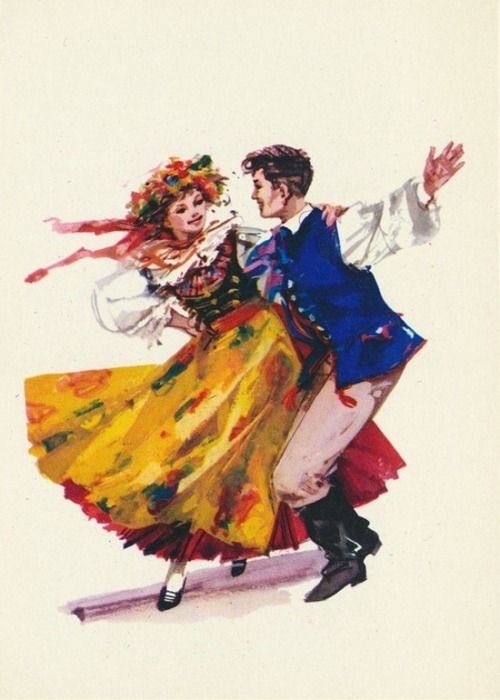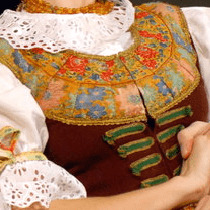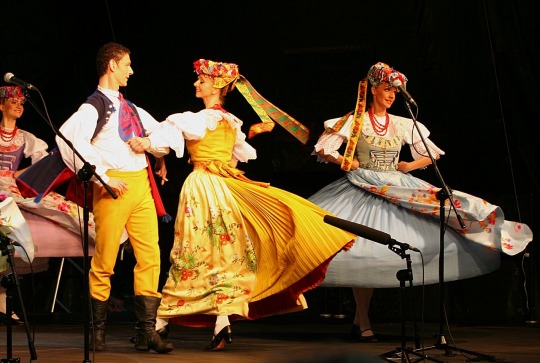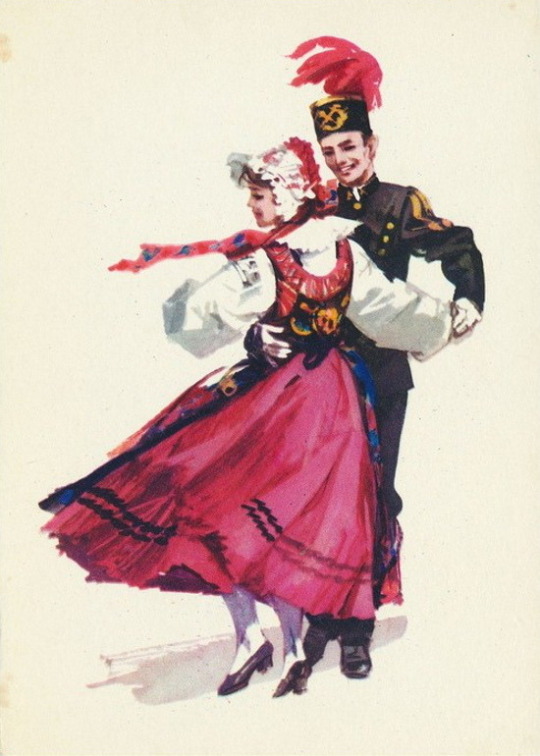#strój rozbarski
Explore tagged Tumblr posts
Text
What did my ancestors actually wear?
I’ve been into historical fashion for a while now and have also been doing a lot of genealogy research about my own family. So while doing research for my costumes, I see all those beautiful gowns and dresses and can’t help but picture my own ancestors wearing them. But now I know better than that and no - they didn’t actually wear the typical western fashion trends of the past centuries.
While the only info I got about my family was from my Silesian grandma and can’t be sure to speak for everyone of my ancestors reaching back until the 1710s (which is how far my research has got me), but apparently, my grandma’s grandma, my great-great-grandma, only wore traditional Silesian costumes, and they were nothing like what I’ve learned from Fashion History.
This is a very new deep-dive for me, I’ve never ventured my way into more traditional folk costumes and there doesn’t seem to be a lot of info about them historically, but I’ve found some things I’d like to share anyways because while learning and knowing about stereotypical garments of a certain time is great, I find it highly interesting to know about my own culture as well.
The majority of my Polish family was from the Częstochowa/Opole area, and I’ve learned that traditional costumes varied even from one town to another, but I’ve found this beautiful postcard drawn by Maria Orłowska-Garbyś showing the Bytom Costume, which looks very similar to the "standard" or most widely spread Silesian costume, the Rozbark Costume.

I’ve found this same picture being labeled as Bytom and Rozbark so I’m gonna go ahead and guess that they were in fact the same costume or very similar, which makes sense as both cities lie very close to each other. So for the purpose of writing this, I’m going to be using them interchangeably (I’m not 100% sure if they’re the same thing though, so take what I’m saying with a grain of salt.)
The Silesian folk costume consisted of:
The undergarments:
A linen band with hooks in the front was worn on the bust in order to flatten it. I have no idea what this band might’ve looked like as I’ve searched the internet and found no pictures at all but I’m assuming maybe it’s about the size of regency stays? It’s described as belt/band though so I really have no clue.
Next up, a sort of sleeveless linen or silk shift was worn on top of that called lajbik (once again, unfortunately no pictures anywhere). To that, they sometimes sewed (or just wore on top) a bumpad to widen the hips and make the waist look smaller -

This one’s a classic, we know that one. It appears all the time when studying Historical Fashion that I almost feel like I don’t have to explain it.
Anyways, they would also sometimes sew the skirt to the shift or garter belts.
Let’s talk about the shirt, which would usually be a white blouse with puff sleeves and lace trims and would also have a big lace collar.

The skirt would be ankle length, big and pleated, light colors being used for younger women and darker colors for older women. The pockets were hidden within the pleats on either side and in the front, there would be a slit which was hidden by the apron worn on top of the skirt.
The apron now - the most colorful piece from this garment. It would cover the whole entire front of the skirt and being also pleated at the waist it was made in a very similar way. The typical floral pattern was not always printed silk but oftentimes it was painted on by hand, which is so fascinating to me. I knew this was a practice back in the days but to think that they actually sat down and painted every single flower on their apron is really really cool. This apron was worn over the final piece, a corset-like vest in usually either red, navy or black (and I guess green?), depending on the person’s age and what town they were from. I’ve found a Bytom version in blue and a Rozbark version in green so that might be the only difference between the two, I’m still trying to understand. The neckline and straps were made of a thick, decorative tape. Overall, this vest was a very decorative piece and wasn’t always worn, but then again, this list I wrote down features only one way of "styling" the outfit as there were many more alternatives and ways of wearing it, but I thought I’d devote my research to the most known version.

All of this then came together with a big flower crown and a huge ribbon in the back, as well as a (usually) red bead necklace.
Here you can see the Bytom version on the left and the Rozbark version on the right with all of its pieces labeled in Polish.


I’ve tried my best to translate some of the info from the Polish wikipedia site (the article is "Strój rozbarski", for some reason it’s not letting me add the link), so if you wanna know more about it (and know Polish) you can read that, it’s a much more detailed description!
Enjoy some more pictures I found:



The last picture is also a postcard by Maria Orłowska-Garbyś showing the Opole version of this costume. It looks slightly different with the cap instead of flowers and the sleeves are longer, that’s why I’m mentioning it! And the black and white photo, that’s more likely what people looked like on a daily basis, I’m assuming the more decorative pieces were added for special occasions.
On an unrelated side note, I’ve unfortunately had to stop the work on my stays for a while due to some issues but I’m hoping to be able to get back to it soon! (They’re almost done I wanna get them done asap). That’s also why I haven’t posted in so long, I’m sorry!
#fashion#historical fashion#traditional fashion#traditional garments#poland#silesia#folk costume#fashion history#strój rozbarski#strój bytomski#polish folk costume#silesian folk costume
83 notes
·
View notes
Photo

Polish Folk Costumes / Polskie stroje ludowe — Folk costume from Bytom, Poland (strój rozbarski)....
1 note
·
View note